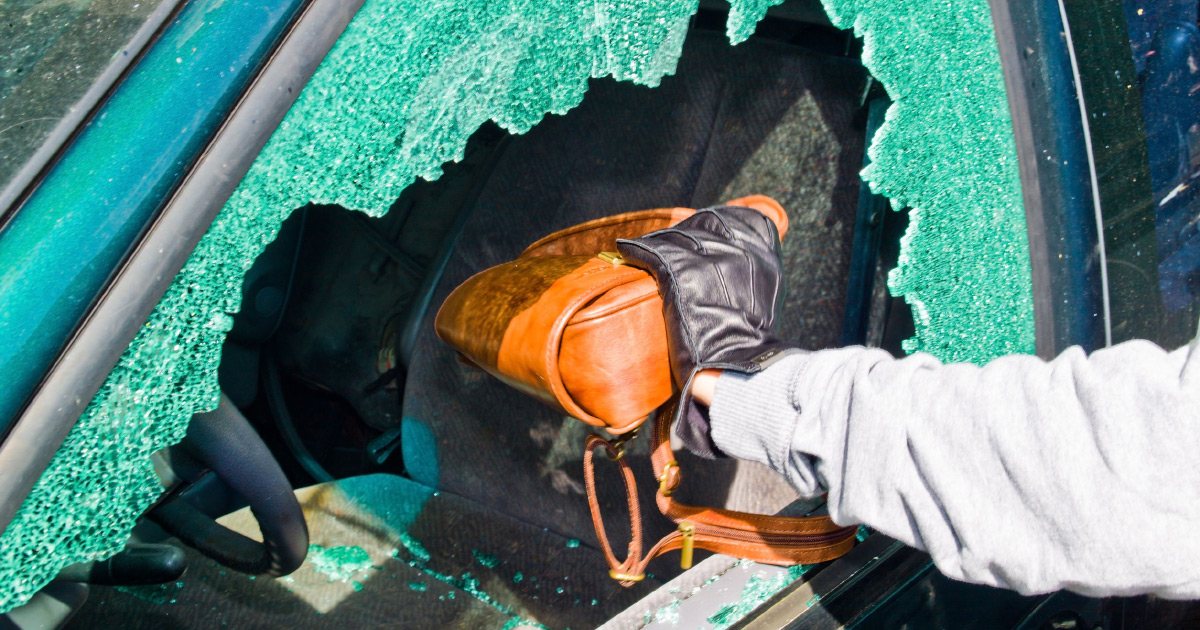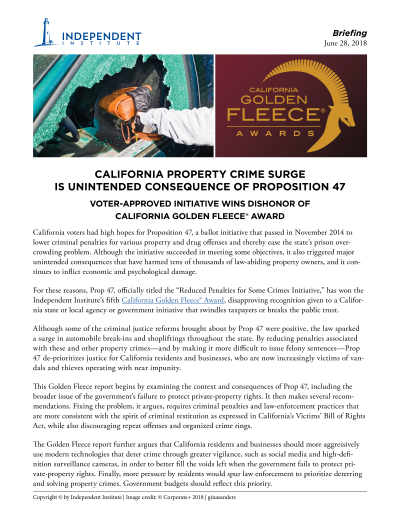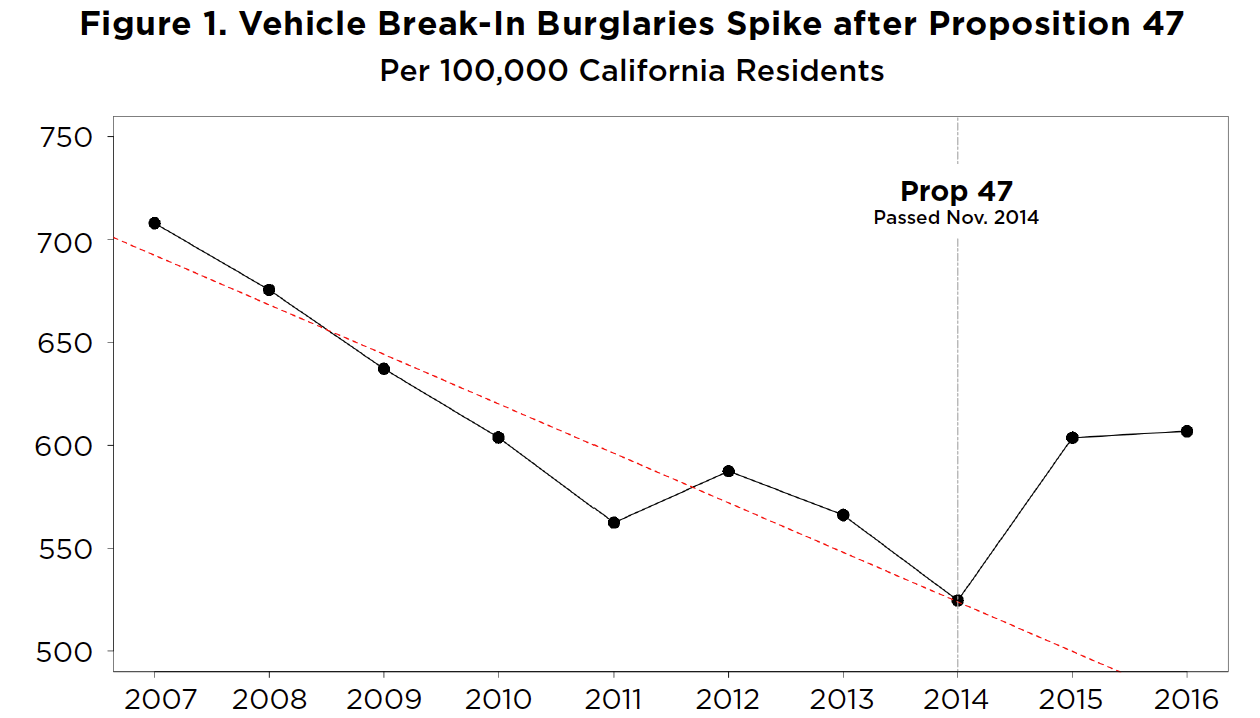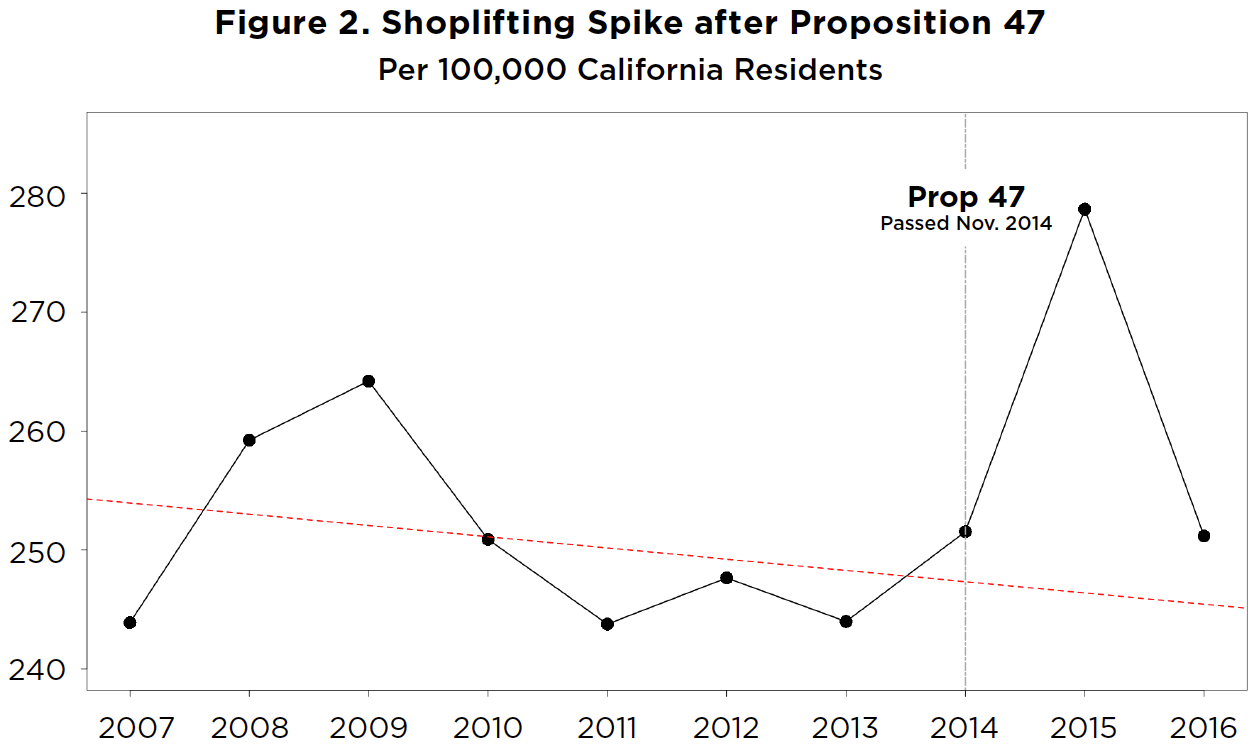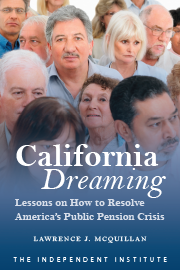California voters had high hopes for Proposition 47, a ballot initiative that passed in November 2014 to lower criminal penalties for various property and drug offenses and thereby ease the state’s prison overcrowding problem. Although the initiative succeeded in meeting some objectives, it also triggered major unintended consequences that have harmed tens of thousands of law-abiding property owners, and it continues to inflict economic and psychological damage.
For these reasons, Prop 47, officially titled the “Reduced Penalties for Some Crimes Initiative,” has won the Independent Institute’s fifth California Golden Fleece® Award, disapproving recognition given to a California state or local agency or government initiative that swindles taxpayers or breaks the public trust.
Although some of the criminal justice reforms brought about by Prop 47 were positive, the law sparked a surge in automobile break-ins and shopliftings throughout the state. By reducing penalties associated with these and other property crimes—and by making it more difficult to issue felony sentences—Prop 47 de-prioritizes justice for California residents and businesses, who now are increasingly victims of vandals and thieves operating with near impunity.
This Golden Fleece report begins by examining the context and consequences of Prop 47, including the broader issue of the government’s failure to protect private-property rights. It then makes several recommendations. Fixing the problem, it argues, requires criminal penalties and law-enforcement practices that are more consistent with the spirit of criminal restitution as expressed in California’s Victims’ Bill of Rights Act, while also discouraging repeat offenses and organized crime rings.
The Golden Fleece report further argues that Californian residents and businesses should more aggressively use modern technologies that deter crime through greater vigilance, such as social media and high-definition surveillance cameras, in order to better fill the voids left when the government fails to protect private-property rights. Finally, more pressure by residents would spur law enforcement to prioritize deterring and solving property crimes. Government budgets should reflect this priority.
Background
Essential to understanding Proposition 47 is the long-term growth of the prison population in California and the nation. The United States is the world’s undisputed leader in incarcerations, with about 1.5 million people held in state and federal prisons at the end of 2016, according to the most recent data from the federal Bureau of Justice Statistics. But the number of incarcerations has not always been so high, even adjusting for overall population growth. Fueled largely by the federal War on Drugs, the prison incarceration rate is now nearly five times as high as in 1970. In California, the surge resulted in massive overcrowding of state prisons, reaching nearly 200 percent of design capacity in 2011.
That year, the U.S. Supreme Court ruled in Brown v. Plata that California’s prison overcrowding violated the constitutional rights of prisoners and required remedial action. In a 5-4 ruling, the Court’s majority found that the state had failed to provide its prisoners with adequate medical services and was subjecting them to cruel and unusual punishment, resulting in violations of inmates’ Eighth Amendment rights. The majority opinion, written by Justice Anthony M. Kennedy, described the conditions as “telephone-booth-sized cages without toilets,” and noted that suicide rates in California prisons were 80 percent higher than among inmates nationwide. The Court’s ruling upheld the decision of a lower federal court that required California to reduce its prison population to 137.5 percent of design capacity.
Following the Brown decision, California voters and state lawmakers passed several laws intended to help reduce the state prison population. In 2011, California Gov. Jerry Brown approved Assembly Bills 109 and 117, requiring new non-violent and non-serious criminals with no histories of sexual offenses to be sent to county jails rather than state prisons. Known as “realignment,” this effort was further supported by a state constitutional amendment, passed by a majority of voters in November 2012, which raised sales taxes and some income taxes to fund new realignment obligations for local governments.
Also in 2012, voters approved Proposition 36, which revised the state’s original 1994 “Three Strikes” law that mandated a sentence of 25 years to life for anyone convicted of a third felony. Henceforth, life sentences would be required after a third conviction only if that conviction involved a “serious or violent” crime or if the convict’s previous convictions involved murder, rape, or child molestation. While effective in reducing the state prison population, these measures failed to bring the overall population down to levels mandated by federal courts.
In November 2014, California voters approved another criminal justice reform with far-reaching consequences: Proposition 47. With nearly 60 percent voter approval, Prop 47 reduced six non-violent felonies (including certain drug offenses) to misdemeanors, and required misdemeanor sentencing for property crimes in which the value of the property involved is less than $950. (The pre-Prop-47 threshold for felony sentencing was $500.) The changes mandated by Prop 47 went into effect immediately, and the initiative allowed for re-sentencing of people convicted and sentenced before passage of Prop 47.
Reactions to Prop 47 have been mixed, with each side passionately defending its claims. Supporters hail the law as a success, noting that it helped reduce the state’s prison population below the federally mandated target almost immediately after its passage. Others, however, have noticed a sharp increase in property crimes. It is no contradiction, however, to say that each side makes a valid point: The problem of state prison overcrowding was reduced, while lighter sentencing rules for various property offenses have exacerbated some types of crime.
Vehicle Break-Ins Surge after Prop 47
One of the most notable changes ushered in by Prop 47 was a sudden increase in the rate of motor vehicle break-in thefts. Informally known as “smash-and-grab” burglaries, these offenses became especially more likely in densely populated cities throughout the state. Vehicle break-ins are by no means a new problem. In fact, break-ins in California were more common in past years (see figure 1). But following years of rapid decline, vehicle break-in rates surged after the passage of Prop 47.
Data about vehicle break-ins during the past decade collected by the California Department of Justice reveal two fascinating patterns. First, the rate of reported smash-and-grab burglaries had been falling before passage of Prop 47. From 2007 to 2014, annual reported break-ins fell by roughly 24 incidents per 100,000 residents. In a state of 39.6 million residents, the decline amounted to an annual drop of about 9,500 vehicle break-ins, or 66,500 fewer reported smash-and-grab burglaries during the seven-year period.
Second, vehicle break-ins jumped sharply immediately after the passage of Prop 47 in late 2014. This surge reversed the downward trend of the previous seven years. In 2015, the rate of smash-and-grab burglaries increased by about 15 percent above the previous year. Vehicle break-ins rose slightly in 2016. For both 2015 and 2016, California averaged about 605 reported thefts from vehicles per 100,000 residents, which is about 21 percent higher than would have been expected in 2015 had pre-Prop-47 trends continued, and about 27 percent higher for 2016. The increase above the previous trend translated to a staggering 51,000 additional thefts statewide in 2016 alone.
Although many areas of California have seen increases in vehicle break-ins since the passage of Prop 47, certain high-density cities have been hit hardest. In San Francisco, where the problem is worst, public officials have called smash-and-grab burglaries an “epidemic.” Although the city has suffered a motor vehicle break-in problem for about a decade, the frequency of such crimes has skyrocketed in recent years.
In 2017, vehicle break-ins surpassed previous records in San Francisco, with 31,322 reported thefts—a 24 percent increase from 2016 levels. This uptick translated to more than one reported break-in in San Francisco every 20 minutes on average. These numbers, however, likely undercount the true theft rate due to a widespread belief that perpetrators will not be caught, an assessment that discourages people from reporting crimes to the police.
Very few smash-and-grab burglaries in San Francisco are resolved. More than 81,500 vehicle break-in reports were filed online from 2011 through 2017, (almost 40 percent of them in 2017 alone), but only 13 online reports led to arrests. Overall, the arrest rate for vehicle break-ins in San Francisco is less than 2 percent. The problem has become so severe that workers at one San Francisco car window repair business reportedly could not take lunch breaks until 4pm on certain days because they were so busy with repairs.
Other Bay Area cities have also been plagued by vehicle break-ins. In 2017, Oakland experienced a record year with 10,007 reported vehicle break-ins, up 32 percent over 2016. Also in 2017, San Jose set a record with 6,476 reported break-ins, a 17 percent increase above 2016.
Southern California cities have also experienced a surge of vehicle break-ins. West Hollywood, for example, has seen a spike in smash-and-grab burglaries. And much like in San Francisco, the thefts occur even in busy areas.
Across the state, one common characteristic of the smash-and-grab burglaries is particularly striking: the property stolen is frequently valued below the felony threshold established by Prop 47. This means that criminals can expect, at most, a misdemeanor citation if they are caught.
Many believe this light punishment has made criminals more brazen, willing to break into cars in broad daylight even with bystanders present. Because Prop 47 redefined felony thresholds, even stealing a car can bring only a misdemeanor sentence if it is valued at $950 or less. As San Francisco police spokesperson Officer Albie Esparza acknowledged, Prop 47 has reduced penalties to “nothing more than a citation.”
For unlucky vehicle owners, the costs of a common break-in are significant. Window repairs generally cost several hundred dollars and often involve lost time from work or leisure. Victims are also out the value of stolen property, unlikely to see it again. Other burdens include replacing stolen items, which may have had irreplaceable sentimental value, and the hassle of dealing with insurance companies. Finally, victims suffer feelings of helplessness and personal violation that come from having an intruder destroy one’s property and rummage through possessions.
Smash-and-grab burglaries are now an everyday feature of Prop-47 California, and many people worry that it is here to stay. Street signs advise people to hide valuables in cars, while helpless vehicle owners tape notes on their car windows trying to convince thieves to spare them.
Shopliftings Spike after Prop 47
Because Prop 47 increased the threshold for felony sentencing and decreased the penalties associated with petty theft, retail shoplifting has also seen a marked increase. As with vehicle break-ins, the increase in retail shoplifting reflects an increase in the expected net benefit to the criminal. The data reveal that criminals responded predictably to the changing incentives.
Shoplifting data from the past decade show that the rate of reported thefts during the five years preceding passage of Prop 47 was lower than the rate immediately after passage (see figure 2). From 2009 to 2014, California businesses reported an average rate of about 248 shopliftings per 100,000 residents, or about 98,000 shopliftings a year, given the state’s current population.
In 2015, the first year of Prop 47’s relaxed rules, the rate of shopliftings spiked by nearly 11 percent over the previous five-year average. That year, about 279 shopliftings were reported per 100,000 residents, roughly 11,000 additional shopliftings throughout the state in the year immediately following the initiative’s enactment. These figures are consistent with FBI crime data, which showed a 12 percent jump in larceny theft.
Shoplifting data for 2016 more closely resemble previous years’ averages, but this similarity likely reflects a decline in reporting behavior rather than decreases in shoplifting incidents. According to Michael Rushford, president of the Criminal Justice Legal Foundation: “More, not fewer, of these crimes are being committed, but people aren’t reporting them. ... They don’t believe anything will happen, so [they] don’t see the point. And they’re right.” Business personnel have responded to shoplifting incidents by underreporting because they have concluded that investigations are a low priority for law enforcement. Some businesses have taken matters into their own hands by increasing private-security measures.
Substantial anecdotal evidence supports the notion that habitual shoplifters are aware of, and responsive to, the punishment they might face in the Prop 47 era. One post in a now-banned Reddit forum for shoplifting informed readers of the dollar value of stolen goods that would result in felony charges in their respective states, so that shoplifters can “stay safe” and “keep it a misdemeanor.” Another post specifically advised California shoplifters to commit their offense “while it’s still covered under Prop 47.”
Business owners have shared personal stories that shed light on shoplifters’ awareness of Prop 47’s penalties. Perry Lutz, who owns HobbyTown USA in Rocklin, California, is one of many who has felt the downside of that calculus—criminals tailoring their shoplifting behaviors to stay under the felony threshold. “They’ll pick up the $800 [drone] unit and just grab it and run out the door,” Lutz told the Associated Press.
A story by USA TODAY reporters is particularly revealing. It captured a criminal from City of Industry (Los Angeles County) directly mocking a police officer:
On a Wednesday morning in late November, [Daniel] Harris bragged about how he keeps his thefts below the $950 threshold, taunting a nearby sheriff’s deputy. That deputy, Joanne Arcos, had caught Harris with loot before, but never enough to really matter.
“I haven’t really committed any felonies—don’t plan on it,” Harris said.
“They’re not felonies anymore,” Arcos responded, annoyed.
“No matter how many times I do it?” Harris asked, with a mocking laugh. “Just kidding.”
The impacts and costs associated with shoplifting are widespread, affecting 95 percent of retailers, according to the National Retail Federation. Much shoplifting is done by organized and coordinated groups of people. Unfortunately, as Capt. John Romero, commander of the Los Angeles Police Department’s commercial crimes division, noted: “[Prop 47] did not give an exception for organized retail theft, so we’re seeing these offenders benefiting and the retailers are paying the price.” That price, of course, is passed on to consumers.
The most recent Global Retail Theft Barometer estimates that globally the average household pays an extra $355 per year due to retail theft. California State Assemblymember Jim Cooper (D-Elk Grove), observed that until Prop 47 is changed, “emboldened thieves will continue to extort the law with no consequences, resulting in increased costs for day-to-day essentials for working class families.”
Evidence that Prop 47 Caused Crime to Increase
Motor vehicle break-ins and shopliftings increased immediately after the passage of Prop 47, breaking with earlier trends. The data and stories are highly suggestive, but correlations are not proof of causation. To better understand the causal effects of Prop 47, we need to know what crime rates would have likely been had the initiative not been implemented. Fortunately, a study forthcoming in the August 2018 issue of Criminology and Public Policy, by University of California, Irvine, criminologists Bradley J. Bartos and Charis E. Kubrin, provides important evidence. Although not yet publicly available, the authors graciously provided an advance copy of their study, “Can We Downsize our Prisons and Jails without Compromising Public Safety? Findings from California’s Prop 47.”
Bartos and Kubrin conducted a quasi-experiment that compared actual California crime rates after the passage of Prop 47 with simulated crime data from a counterfactual, “synthetic California” imputed using crime data from other similar American states. The researchers investigated the potential effects of the law on rates of seven types of crime, including four violent crimes, and found evidence that larceny thefts, a category that includes shopliftings and smash-and-grab burglaries, increased sufficiently above the simulated counterfactual data level to attribute the cause of the crime increase to Prop 47.
Bartos and Kubrin’s study, the first to examine the effects of Prop 47, gives good reason to conclude that the passage of the initiative caused a rise in smash-and-grab thefts and shopliftings by increasing the expected net benefit of these criminal activities. And when post-experiment sensitivity tests are properly considered, the study provides even greater confidence in this assertion (see the Technical Appendix).
Pathologies of Government: The Economic and Human Costs of Weak Enforcement of Private-Property Rights
Governments are entrusted with a bundle of important responsibilities, chief among them are the protection of individual rights to life, liberty, and property. A government that fails to protect any of these rights neglects to perform its most basic duties. Unfortunately, by reducing the penalties associated with property crimes, Prop 47 weakens protections of property rights for people in California. And the results are clear: criminals have been empowered, resulting in more motor vehicle break-ins and shopliftings.
These spikes in property crimes are not coincidental. A briefing by the Center on Juvenile and Criminal Justice (CJCJ) demonstrates that, in the years since the enactment of Prop 47, property crimes involving larceny have increased despite stability in overall California crime rates. The Bartos and Kubrin study finds the clearest evidence for a link between these specific property crimes and Prop 47’s implementation, rather than a change in overall crime rates. These findings are also consistent with investigative reports, police accounts, and first-hand admissions from thieves showing that the initiative changed their calculus in a manner detrimental to Californians broadly. Criminals are calculating actors who respond predictably to changes in the expected net benefits of criminal activity.
Politicians are also rational actors, albeit ones facing a different set of incentives and constraints. Elected officials are aware that they may win more votes and campaign contributions by starting a new government program, such as building a new bullet train or water tunnel, which has concentrated beneficiaries, rather than by enhancing public safety generally. Police and fire resources often get squeezed out of government budgets so that politicians can pay for shiny new projects. Public safety can become an afterthought.
The premise of Prop 47 was laudable. By stemming the flow of non-violent criminals to prisons, law enforcement could theoretically focus its energies on pursuing “serious criminals.” It is a mistake, however, to consider all non-violent crimes to be “non-serious” and to reduce the criminal penalties associated with them uniformly and haphazardly. While drug addiction is increasingly seen as a public health issue, it is not compassionate to overlook the victims of motor vehicle burglaries and shoplifting. Providing opportunities for criminals to game the system and avoid consequences for committing these crimes—often criminals in organized groups of repeat offenders—makes California less safe and imposes an unfair burden on residents, business owners, and visitors.
One risk associated with government’s failure to protect individual rights is that the pendulum will swing back too far in the other direction. Conor Friedersdorf points out in The Atlantic that when the public notices an epidemic of uncontrolled crime, it may reach a breaking point that leads to growing demands for extreme policy responses of an overly punitive nature. Such a backlash would be counterproductive to the spirit of Prop 47 and could potentially lead California back down the path to overcrowded prisons. Overreactions also pose a serious threat to liberty as the public demands more heavy-handed policing to restore public order and security.
For these reasons, it is imperative that Californians fix the unintended consequences of Prop 47.
The Recommendations: Penalties Commensurate with the Crime, Civilian and Business Empowerment, and Law-Enforcement Prioritization of Property Crimes
Campaign supporters of Prop 47 referred to it as the “Safe Neighborhood and Schools Act,” but the ballot initiative quickly produced a sharp increase in neighborhood crimes. Reversing this unintended consequence requires implementing a set of fixes. First, laws should be reformed to prioritize victim compensation through restorative justice, while discouraging crime rings and repeat offenses by combining the value of stolen property for sentencing purposes. People and businesses should also increase their use of modern security technologies and measures to reduce reliance on government police for crime prevention. Police should prioritize property crimes, regardless of whether they believe arrests will have a lower likelihood of serious sentencing. And residents should demand police reprioritize property crimes and demand that government budgets reflect this reprioritization.
Punishment that fits the crime
Prop 47 appropriately reduced penalties associated with numerous non-violent drug offenses considered victimless crimes. But property crimes such as vehicle break-ins and shoplifting have many true victims and should be handled differently. In short, punishment should fit the crime.
The principles of proportionality and victim restitution are key. First-time offenders who commit crimes involving very low-value property should be given lighter misdemeanor sentences than repeat offenders or criminals involved in higher-value property crimes. As per California’s Victims’ Bill of Rights Act, sentencing should involve payment of restitution to victims, though it might also include a short jail stint to discourage future acts. The primary goals are to make victims whole, while not being excessively punitive. Crimes involving property of greater value, however, should be treated as more serious crimes eligible for larger penalties including longer jail time along with restitution. Policymakers and the public should consider reducing the threshold separating misdemeanor theft (petty theft) from felony theft (grand theft) from $950 to an amount closer to the pre-Prop-47 amount of $500. And smashed vehicle windows should be legal proof of unlawful entry.
Repeat offenders should face stiffer penalties than first-time offenders. When considering sentencing, courts should be allowed to consider the total combined value of property across multiple property crimes. Once the combined value of property involved reaches the threshold amount, the offense should be sentenced as a felony. Existing law allows for the aggregation of thefts “if motivated by one intention, one general impulse, and one plan.” Assembly Bill 3011, sponsored by Assemblymember Ed Chau (D-Monterey Park), clearly defines and allows aggregation in the context of Prop 47. Introduced in February 2018, the bill is pending in the Assembly. Elevating penalties for petty theft for individuals with prior offenses was one of the features of legislation introduced by Assemblymember Cooper to reform Prop 47, but the bill was shelved in committee earlier in 2018.
Finally, reforms should be implemented that combat theft by organized crime rings. These groups can accumulate great quantities of stolen property and sidestep the higher felony thresholds of Prop 47 by employing numerous thieves who each engage in petty theft. A proposal from Assemblymember Reggie Jones-Sawyer (D-South Los Angeles) would create a new category of crime for participants in organized retail theft, which could be punishable as either a misdemeanor or felony depending on severity. Another possibility is to aggregate offenses among fellow conspirators when those crimes can be linked. This aggregation would discourage individuals from joining organized crime rings to game the current, more lenient environment.
Greater civilian and business vigilance
Crime prevention can also be enhanced through increased personal vigilance. Today, civilians and businesses have access to many technologies that empower them to detect and prevent property crimes before they occur. At a time when arrests for lower-value property crimes are a lower priority, reducing reliance on police is a smart strategy.
More aggressive use of high-definition cameras would be useful for both deterrence and as an investigative tool, recording activity at homes, businesses, parking garages, and on the streets. With the “Internet of Things” and smartphones, video can be fed to property owners and private-security services in real time, alerting them to suspicious activity.
Wider use of social media networks would also help people avoid becoming the next victim. Social media provide people with a way to connect with each other and share burglary warnings at an instant. One network in particular, Nextdoor, is oriented around forming online communities defined by geographic neighborhoods. On its site, members discuss topics ranging from community events to noise complaints. They also share information regarding recent burglaries in the community, provide photos from home security cameras of suspected criminals, and offer tips on how to avoid becoming the next victim. Some law-enforcement agencies have used Nextdoor and other social networks such as Twitter to reach residents of specific communities affected by crime. This has given Californians the ability to form digital neighborhood watch groups, lowering their odds of becoming crime victims.
News stories laud the success of social media tools to reduce crime. Rather than confronting criminals directly, these digital neighborhood watch groups help residents avoid being targeted and pass information to police that can lead to the arrest of serial criminals. Citizens should make greater use of modern technologies to make their homes, businesses, and communities safer.
Businesses, for their part, could take specific actions that would reduce larcenies, such as investing in locked display cases, security cameras, and private loss prevention agents. Before it was removed for violating site terms, the Reddit forum on shoplifting contained frequent posts from individuals caught stealing merchandise on store surveillance cameras and confronted by security at specific retailers. The common advice: avoid these particular stores in the future and instead focus on stores without adequate means to catch a thief in the act. Particularly effective in reducing shoplifting, according to a study of loss prevention in retail stores, is the presence of uniformed security personnel.
Businesses suffering high levels of theft can also modify their return policies in order to fight “return fraud,” a crime that often begins with shoplifting. Habitual shoplifters are attracted to stores that allow them to return merchandise without a receipt, often in exchange for a store gift card that can be sold for quick cash. Some stores have opted to only provide in-store credit, whereas others will not accept returned merchandise without proof of purchase. These policies are less convenient for legitimate shoppers, but they may be necessary to combat the growing costs associated with increased shoplifting.
Prioritize property crimes
Investigation, arrest, conviction, and punishment remain an effective deterrence to some criminals. Because a more lenient environment under Prop 47 caused law enforcement to de-prioritize petty theft, it would be helpful for police to prioritize arrests for property crimes. The flood gates to crime need not be opened. Public pressure should be exerted on government and police officials to re-prioritize property crimes and have government budgets reflect this re-prioritization. Some changes have already occurred in San Francisco.
The San Francisco Police Department (SFPD) has been forced to confront head-on the increasing rate of smash-and-grab thefts. The city and SFPD launched the “Park Smart” campaign to educate motorists in highly-targeted areas of the city, many of whom are tourists, to remove valuables from their parked cars.
The SFPD also adopted new policing strategies. As part of its community-based policing, the department increased foot-beat patrols from 76 officers in September 2017 to 140 officers by April 2018. Also, SFPD created dedicated teams of officers at each neighborhood police station focused on property crimes. It also assigned 10 investigators to work exclusively on auto break-in cases as part of a centralized investigative unit. SFPD has dedicated a larger share of its resources to combating property crimes such as car break-ins, including assigning officers to known hot spots.
Theft from vehicles in San Francisco fell 17 percent in the first three months of 2018 compared to the same period in 2017. Police have renewed efforts to actively pursue thieves, including busting an organized crime ring in January 2018 and making 11 arrests in five days in April 2018. The goal is to disrupt rings of organized career criminals involved in vehicle break-ins.
Pursuing arrests for property crimes is also important if sentencing laws change in the future. For example, if lawmakers allow criminal sentencing decisions to reflect the combined value of stolen property by repeat offenders, then law-enforcement officers should pursue arrests even for small crimes so that track records are established. Along these lines, in April 2018 the SFPD announced it would place greater emphasis on collecting fingerprints from auto break-ins in a bid to identify serial offenders.
Monetary rewards for information leading to the arrest and conviction of repeat offenders is a strategy that could save time and money for police departments and result in higher arrest rates.
Prioritizing arrests will encourage residents and businesses to report more property crimes. As noted earlier, many Californians have given up believing that perpetrators will be caught and held accountable for their crimes, so they do not file reports. More vigorous and effective efforts on the part of police departments and the courts can stem the public’s despair, restore confidence, improve community cooperation and collaboration, and thereby amplify the positive impact of law enforcement.
Property crimes produce true victims. Californians deserve a legal system that provides true justice.
Technical Appendix*
The Bradley Bartos and Charis Kubrin study included a set of misinterpreted post-experiment tests that caused them to mistakenly call into question their own results. These issues have been brought to the attention of the authors of the study.
Bartos and Kubrin questioned whether the increase in larcenies they observed was actually caused by Prop 47. The researchers performed a sensitivity test that removed the four most important states in estimating larceny rates from their synthetic state model, in essence changing its construction completely, and then evaluated whether actual 2015 California larceny data exceeded their new synthetic state estimate. They observed that “the estimated effect is dependent on the contribution of certain donor pool states,” provoking them to conclude that their finding that Prop 47 lead to an increase in larcenies “should be interpreted cautiously.” The result of their sensitivity test is predictable, however, and does not call into question their earlier finding.
By removing all of the most influential states in their original synthetic California model, Bartos and Kubrin degraded the quality of their comparison (control) estimates. For various reasons, they might suspect one or two of these donor states drove their earlier results, but removal of all four states clearly produced inaccurate synthetic state estimates. The middle panel of figure 2 in their fact sheet demonstrates that their original synthetic California model actually mirrored real larceny data well. But their alternative model produced control-group estimates that were systematically higher than real state crime rates in every single year starting in the mid-1990s (figure 3 of their forthcoming study). Given their alternative model’s tendency to overestimate crime rates in every single year leading up to the implementation of Prop 47, there is strong reason to believe their control estimate for 2015 was also overestimated. This outcome, of course, is the product of relying on an imprecise alternative model; poorly fit models necessarily make it difficult to detect whether an intervention of any type had an effect. Fortunately, the original model produced by Bartos and Kubrin allows us to conclude, with greater certainty, that implementation of Prop 47 did produce an increase in larceny thefts.
*Statistical consultation on the technical appendix was provided by Hovannes Abramyan, PhD.
Each quarter, Independent Institute highlights a California state or local government spending program, tax, or regulation that fleeces
taxpayers, consumers, or businesses. The California Golden Fleece® Awards shine a spotlight on waste, fraud, and abuse in California
government to give valuable information to the public, enabling them to provide needed oversight and demand meaningful change.
Fleece award winners are announced quarterly on Independent.org and posted on Independent’s Twitter, Facebook, LinkedIn, and Instagram. We encourage people—both inside and outside of government—to send us Fleece candidates. To learn more and to submit your candidates, go to www.independent.org/cagoldenfleece.


